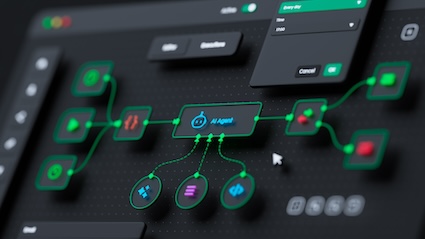
Accelerating Mission Outcomes with Agentic AI: A Practical Guide for Federal Leaders

Contributors for this blog are Bridget Deary, Partner, IBM Consulting Federal, Mark Fisk, Partner, IBM Consulting Federal, Chuck Royal, Associate Partner, IBM Consulting Federal, and Tony Vachino, Associate Partner, IBM Consulting Federal.
Accelerating Mission Outcomes with Agentic AI: A Practical Guide for Federal Leaders
Agentic AI is rapidly reshaping the way organizations operate, promising a new era of autonomy, adaptability, and mission impact. But what exactly is Agentic AI, and how can federal agencies harness its power to overcome longstanding challenges and deliver real results?
What Is Agentic AI? The Next Leap in Autonomy
Agentic AI is more than just another buzzword in artificial intelligence. Unlike traditional AI, which follows predefined rules or generates content on command, Agentic AI systems act as independent agents: they perceive their environment, set goals, make decisions, and take actions—all with minimal human intervention. Think of Agentic AI as a trusted digital teammate that not only understands your objectives but proactively finds the best path to achieve them, learns from every interaction, and adapts in real time to changing circumstances.
These systems are built from networks of AI agents, each specializing in specific tasks, collaborating to solve complex, multi-step problems. The result? Workflows that are more efficient, flexible, and resilient—freeing up human talent for higher-value missions.
Why Federal Agencies Need Agentic AI Now
Federal agencies, are under unprecedented pressure to modernize, innovate, and do more with less. Executive Orders and agency mandates now require outcome-focused innovation, rapid adoption of AI, and measurable impact on mission delivery. Agentic AI is uniquely positioned to meet these demands by:
- Automating complex, cross-agency workflows
- Enabling real-time decision-making
- Scaling expertise and insights across the enterprise
- Improving data-driven outcomes while maintaining compliance and transparency
Four Core Challenges on the Path to Agentic AI
While the vision is clear, the journey is not without obstacles. Federal agencies face four main hurdles:
- Data Integration Without Ownership: Much of the data needed for effective AI is scattered across agencies, partners, and external sources. Integrating this data securely and efficiently—despite privacy, proprietary, or interoperability issues—is a top challenge.
- Ensuring Data Quality and Trust: AI is only as good as the data it consumes. Inconsistent metadata, unstructured information, and siloed systems can undermine trust and performance.
- Legacy Systems and Automation: Outdated infrastructure and fragmented automation limit the ability to deploy AI at scale. Modernizing incrementally, without disrupting mission-critical operations, is essential.
- Integrating Commercial Tools with Modular Architecture: The commercial AI sector is innovating at a breakneck pace, but federal IT systems often lack the modular, API-driven architecture needed to plug in new tools quickly and flexibly.
How Agentic AI Overcomes These Barriers
Agentic AI frameworks are designed to address these challenges head-on:
- Seamless Data Integration: By leveraging ontologies and knowledge graphs, Agentic AI can connect and contextualize data from diverse sources, making it discoverable, trustworthy, and actionable.
- Real-Time Adaptability: Agentic systems learn from every interaction, continuously improving their decision-making and adapting to new data and mission needs.
- Legacy-Friendly Modernization: Agentic AI can layer on top of existing systems, maximizing the value of prior investments while incrementally introducing new capabilities.
- Modular, Open Architectures: Modern Agentic AI solutions are built to be modular and standards-based, allowing agencies to integrate best-in-class commercial tools without vendor lock-in.
Real-World Impact: Agentic AI in Action
Agentic AI is already delivering value across government and industry:
- Automated HR and Procurement: AI agents handle millions of HR queries and transactions, freeing up staff for higher-value work and accelerating procurement cycles.
- Mission-Critical Operations: In defense, Agentic AI platforms are integrating data from sensors, documents, and external sources to provide real-time intelligence and streamline mission planning.
- Accelerated Compliance and Innovation: Agentic AI helps agencies meet evolving federal mandates for transparency, auditability, and risk management—while enabling rapid, compliant innovation.
Getting Started: A Practical Roadmap
Federal leaders looking to unlock the potential of Agentic AI should focus on:
- Prioritizing High-Value Use Cases: Start with processes that offer the greatest potential for impact and scale.
- Mapping Current Systems and Data: Assess where your data lives, how it’s structured, and where integration gaps exist.
- Building Modular, Open Architectures: Invest in flexible IT frameworks that can evolve as new AI tools emerge.
- Fostering Cross-Functional Teams: Bring together mission owners, data experts, and technologists to ensure solutions are aligned with real-world needs.
- Emphasizing Security and Compliance: Ensure that every step of your AI journey meets federal standards for transparency, auditability, and risk management.
The Bottom Line
Agentic AI is not just the next step in automation—it’s a fundamental shift in how agencies can achieve their missions. By enabling systems to act, learn, and adapt, Agentic AI empowers federal leaders to break through long-standing barriers, deliver measurable outcomes, and build a future-ready government.



